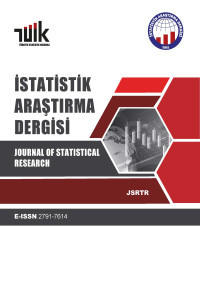Biyokimyasal Reaksiyonlar için Stokastik Simülasyon Algoritmalarına Genel Bir Bakış
Matematiksel modelleme, Simülasyon, Stokastik algoritmalar
An Overview to Stochastic Simulation Algorithms for Biochemical Systems
Mathematical modelling, Simulation, Stochastic algorithms,
___
- Auger, A., Chatelain, P., Koumoutsakos, P., 2006. R-leaping: Accelerating the stochastic simulation algorithm by reaction leaps.
- Bower, J. M., Bolouri, H., 2001. Computational modelling of genetic and biochemical networks. Massachusetts Institute of Technology.
- Brent, R., 2004. A partnership between biology and engineering. Nature Biotechnology, 22:469–482.
- Cao, Y., Gillespie, D. T., Petzold, L. R., 2005. Avoiding negative populations in explicit poisson Tau-Leaping. Journal of Chemical Physics, 123:054104.1-054104.8.
- Cao, Y., Li, H., Petzold, L., 2006. Efficient formulation of the stochastic simultion algorithm for chemically reacting system. Journal of Chemical Physics, 121 (9): 4059-4067.
- Endy, D., Brent, R., 2001. Modelling cellular behaviour. Nature, 409:391–395.
- Fedoroff, N., Fontana, W., 2002. Genetic networks: Small numbers of big molecules. Science, 297:1129–1131.
- Gibson, M. A., Bruck, J., 2000. Efficient exact stochastic simulation of chemical systems with many species and many channels. Journal of Physical Chemistry, A(104):1876–1889.
- Gillespie, D. T., 1977. Exact stochastic simulation of coupled chemical reactions. Journal of Physical Chemistry, 81(25):2340–2361.
- Gillespie, D. T., 1992. A rigorous derivation of the chemical master equation. Physica A, 188:404–425.
- Hume, D. A., 2000. Probability in transcriptional regulation and its implications for leukocyte differention and inducible gene expression. Blood, 96:2323–2328.
- Jong, H. D., 2002. Modeling and simulation of genetic regulatory systems: A literatüre review. Journal of Computational Biology, 9 (1), 67-103.
- Kampen, N. G. V., 1981. Stochastic Processes in physics and chemistry. Elsevier.
- Khanin, R., Wit, E., 2006. How scale-free are biological networks. Journal of Computational Biology, 13 (3), 810-818.
- Kitano, H., 2001. Foundations of systems biology. Massachusetts Institute of Technology.
- Lok, L., 2002. Pathfinder and other tools for analyzing signal transduction networks. Ann. N.Y. Acad. Sci., 971:589-594.
- Lok, L., Brent, R., 2005. Automatic generation of cellular reaction networks with moleculizer 1.0. Nature Biotechnology, 23(1):131–136.
- Morton-Firth, C., Bray, D., 1998. Predicting temporal fluctuations in an signalling pathway. Journal of Theoretical Biology, 192:117–128.
- Purutçuoğlu, V., Wit, E., 2006. Exact and approximate stochastic simulations of the APK pathway and comparisons of simulations’ results. Journal of Integrative Bioinformatics, 3, 231-243.
- Purutçuoğlu, V., Wit, E., 2008. Bayesian inference for the MAPK/ERK pathway by considering the dependency of the kinetic parameters. Bayesian Analysis, 3 (4), 851-886.
- Purutçuoğlu, V., 2010. Stochastic simulation of large biochemical systems by approximate Gillespie algorithm. Proceeding of the 5rd International Symposium on Health, Informatics and Bioinformatics, IEEE Xplore, 181-186.
- Turner, T. E., Schnell, S., Burrage, K., 2004. Stochastic approaches for modelling in vivo reactions. Computational Biology and Chemistry, 28:165–178.
- Wilkinson, D.J., 2006. Stochastic modelling for systems biology. Chapman and Hall/CRC.
- ISSN: 1303-6319
- Başlangıç: 2002
- Yayıncı: TÜİK
Malmquist Endeksi ile 25 Ülkenin Ortaöğretim Performansının Değerlendirilmesi
Tekrar Satılabilir Ürünler için Gazeteci Çocuk Probleminin Çelişen Amaçlar Altında İncelenmesi
Umay UZUNOĞLU KOÇER, Mutlu KARA
Türk Reel Sektörü için Karşılaştırmalı Etkinlik Ölçümü: Veri Zarflama Analizi Uygulaması
Tek Değişkenli Zaman Serilerinde Model Seçim Ölçütleri Üzerine Bir İnceleme
Kümeleme Çözümlemesinde Düzeltilmiş Tek Adım M-Tahmin Edicisinin Kullanılması
Abdullah Fırat ÖZDEMİR, Engin YILDIZTEPE
Türkiye’de Enflasyon Katılığının Araştırılması: Parametrik Olmayan Bir Yaklaşım
Saygın ŞAHİNÖZ, Bedriye SARAÇOĞLU
Biyokimyasal Reaksiyonlar için Stokastik Simülasyon Algoritmalarına Genel Bir Bakış
Değişim Katsayılarının Eşitliğine İlişkin Testlerin I.Tip Hata ve Güç Bakımından Karşılaştırılması
